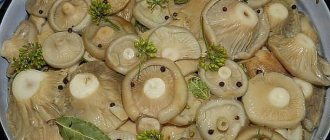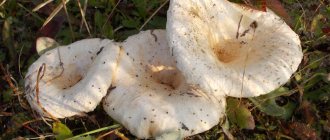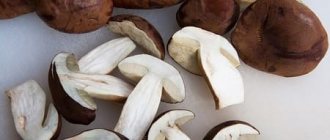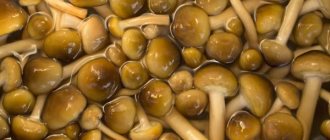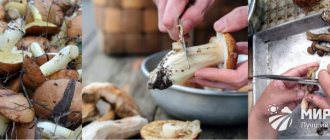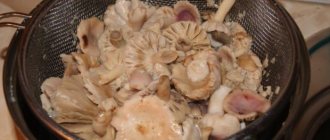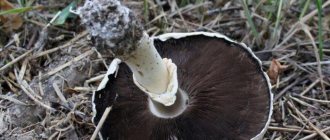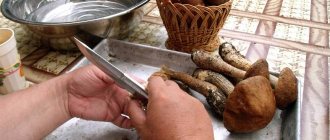Since before cooking milk mushrooms you need to soak them to get rid of bitterness, you need to clean them after that. There are several ways to clean milk mushrooms.
Before cooking, any mushrooms are sorted, including milk mushrooms. We need to pick out all the rotten and wormy ones. Most often, they are not suitable for food, since rot and worms affect both the stem and the cap. Dense, elastic specimens are considered the best in quality, but loose ones are better to be put aside. The mushrooms are first cleaned of leaves, blades of grass and other debris and washed under running water to remove dirt. In general, milk mushrooms are soaked for about a couple of days, changing the water every few hours. Only after all preliminary measures have been carried out can you begin to clean them. During the process, after soaking, all spoiled areas are cut off.
What types of milk mushrooms are there?
In order not to confuse the milk mushroom with its doubles and not throw away the edible mushroom, it is important to know what they are.
The most famous ones are white. They are also called real, pepper or wet. They have a very pronounced bitter taste, which is why they must be soaked before cooking and cleaning, as described above. Black milk mushrooms, as the name suggests, have dark caps. In order not to spoil the dish, it is recommended to cook and salt them separately from white ones due to the milky juice and sticky substance with which they are coated. They should be washed especially thoroughly before cleaning.
Not everyone collects dry milk mushrooms. Despite the fact that they are also edible, their appearance repels even experienced mushroom pickers. At the same time, this mushroom is not bitter, being, in fact, one of the types of russula, and not a real milk mushroom.
Features of collection
Depending on the region, milk mushrooms should be collected from August until the last days of September.
When collecting milk mushrooms, you need to adhere to the same rules as when going for other mushrooms:
- The sooner you go into the forest, the greater the likelihood of becoming the first pickers.
- Leaving early in the summer will help you collect mushrooms that the sun will not have time to heat. In this case, they will be stored longer than those heated by the sun.
- You need to choose a route so that the sun does not hit your eyes, but most of the time it is located and, accordingly, shines from behind or from the side.
Not all varieties are safe, so it is important to familiarize yourself with which ones you can eat and which ones are best left in the forest.
Conditionally edible are:
- white milk mushrooms - they are white or slightly bluish. When soaked in water, they may change and become grayish or greenish in color;
- black milk mushrooms - their caps have a brownish-greenish color.
In their natural habitat, edible mushrooms are found in various forests, mainly birch and pine-birch. They tend to grow in large families next to trees with which they form mycorrhizae.
You can recognize them by their flat-convex cap with a dense structure. The skin is slimy, the color of young mushrooms is milky, and that of older mushrooms is yellowish.
The plates under the caps are frequent and wide. With age, they acquire a rich yellow tint and become covered with brown spots. It is not recommended to eat such specimens.
Clean milk mushrooms correctly!
Each stage of mushroom preparation is important. And cleaning is one of the main points. Many recipes don't even mention that mushrooms need to be cleaned. But starting to cook without pre-processing is at least reckless. Mushrooms are heavy food, and the largest amount of harmful substances always accumulates in the upper covers. Mushrooms themselves absorb everything harmful from the environment, which is why properly processing them before pickling or frying is a matter of life and health for you and your family.
So, when the mushrooms have already been soaked for several days, all the spoiled areas have been cut off, we begin cleaning. This is convenient to do with a stiff brush. To avoid searching for anything in stores, use any unnecessary toothbrush. Also a good, but less convenient option is a dish sponge with a hard surface. The mushrooms are cleaned to an even white color. Sometimes you can find information that black and white milk mushrooms are cleaned the same way. In principle, this is true, but you also need to additionally remove mucus from the black ones, which does not improve the taste of the finished dish.
Dry milk mushrooms are not soaked for days because they do not taste bitter. They can be cleaned almost immediately. The only secret is that mushrooms soaked in boiling water are much easier to clean. After soaking, the hat becomes soft and it is much more convenient to clean it of dirt by simply placing it under running water. Dry milk mushrooms do not need to be kept in brine for a long time, since they do not secrete bitter milky juice, like white and black ones.
A little about basic cleaning
After 1-2 days, rinse the milk mushrooms thoroughly and place them in clean water at room temperature. Peel each white mushroom separately. Clean the hat with a toothbrush (stubborn dirt) or a dishwashing sponge if the dirt can be easily washed off. Wash in circular motions without damaging the surfaces. Using a knife, scrape off the spore-bearing layer from the inside of the cap, since grains of earth and sand usually accumulate there.
If the milk mushroom is large in size, it is recommended to cut it into several parts for ease of cleaning from contamination. The mushrooms need to be peeled until white and the stems should be trimmed.
The cleaned milk mushrooms need to be rinsed in the water with which they are filled and transferred to a clean pan or bucket of water. Already peeled milk mushrooms should stand for another day in salted water. And only the next day, after washing under running water, should you start salting them.
The most proper soaking is done with running water. In the city this method is not very convenient. But in villages and villages, you can use soaking milk mushrooms under running water. To do this, take a bag or package made of material that allows water to pass through and fill it with mushrooms, then attach it to the crossbar and place it between the banks of the stream. If this happens in a river, then tie the rope holding the neck of the bag to a stake driven into the ground. In this case, the object itself must be in water. The mushrooms are left in this position for several days, after which they are removed, cleaned and salted.
Lovers of salty and crispy milk mushrooms should be careful when salting, as if handled incorrectly there is a risk of losing their taste and color.
Hot salting method
Mushrooms are most often salted hot, and milk mushrooms are no exception.
After preliminary preparation, when they are soaked, dried and properly cleaned, they are placed in an enamel container and boiled for about half an hour. Then the mushrooms are taken out of the water and laid out on a wide dish. It is better not to pour out the broth. If the mushrooms have been previously prepared and cleaned properly, then the broth is edible. It adds incredible flavor to any sauce or soup. In a separate bowl, prepare the brine in the proportion of 1 liter of water: 2 tbsp. l. salt, black and allspice, other seasonings.
Milk mushrooms are boiled in boiling brine for about half an hour. Add horseradish and garlic there.
Afterwards they are put under oppression. They cover the top with a plate, and some kind of pressure is placed on it. The easiest way is to put a jar of water. The mushrooms will begin to release water, which will eventually cover them. If little water has been released, add the brine in which they were boiled.
The mushrooms remain under pressure for about a month, and then they are put into jars. You can cover with cabbage leaves and place under nylon covers.
Is a water change necessary?
Before the main cleaning, milk mushrooms must be soaked in water, otherwise they will become bitter later.
Before the main cleaning, milk mushrooms must be soaked, otherwise they will taste bitter. Therefore, during the day it is necessary to change the water at least 5 times, and preferably every 3-4 hours.
If you increase the time between water changes, the milk mushrooms may turn sour. The water should always be cold.
Before draining the water from the container, you need to rinse the milk mushrooms in a circular motion.
Then, holding the lid, drain the water so that the mushrooms do not fall out. Pour clean water and cover with a lid with a weight.
Filled milk mushrooms should stand in a dark and cool place.
Do not use warm or hot water, as the mushrooms will become soft and unsuitable for further cleaning. If you start cleaning such a mushroom, it will break and crumble.
Cold salting method
It takes much longer than the hot version, but it is somewhat simpler.
The milk mushrooms are cleaned of dirt, sticks, twigs, washed under running water and placed to soak. After the required time has passed, the mushrooms are cleaned using a stiff brush or sponge with a hard cleaning surface.
After this they are cut into pieces. The ideal option for cold pickling is slicing. This is easy to do if you cut the mushroom into triangles, starting from the cap.
Sliced mushrooms are poured with water and placed under pressure. The main thing is to optimally select the weight of the oppression so as not to simply crush the mushrooms.
The mushrooms should be soaked for about a week. To prevent water from stagnating and spoiling, it must be changed daily.
When a week has passed, the water needs to be drained and the mushrooms inspected. If necessary, all damaged areas are trimmed.
The mushrooms are then washed again and covered with salt. Iodized salt, despite all its usefulness, is better not to use. Mushrooms may turn black and lose their attractive appearance, although their taste will not be affected.
Mix again and put under heavy pressure. Stir occasionally, as the milk mushrooms will release juice during the pickling process.
After three days, mix the mushrooms again. Mushrooms are tightly packed into sterilized jars and filled with brine. There is no need to seal the jars, but you can simply close them with plastic lids and put them in the refrigerator.
Collection and preparation for use
Milk mushrooms are white mushrooms with a cap diameter of 5-20 cm. Mushroom pickers are not always able to notice them from under the leaves and dry grass. These mushrooms are collected using a stick. They use it to stir up the forest floor in search of a trophy. Young specimens of small and medium size are considered the most valuable.
Irina Selyutina (Biologist):
Raw or white milk mushrooms are not common, but they always form large families. When searching for these mushrooms, it is important to find at least one and then you will find others. In search of representatives of this species, mushroom pickers inspect clearings in birch groves, as well as the northern slopes of hills and slopes. Fruiting bodies grow from year to year in the same place. The good thing is that worms do not really like milk mushrooms for their milky juice. Compared to the cap, the leg of this species is simply miniature, so it can be quite difficult to see the cap. When arming yourself with a stick to search, you need to take into account the fact that with it you can accidentally damage the cap or, even worse, the mycelium. In the second case, within a few years you will have to forget about the treasured place.
To make your task easier in the future, you begin to process and clean milk mushrooms during the collection period, i.e. already in the forest. To do this, before cleaning, the cut mushroom is inspected for damage by worms. Small ones are carefully trimmed, and for large ones, the entire fungus is removed.
Hidden insects and slugs are removed under the fringe. They also need to be cleaned of debris adhering to the cap and soil at the bottom of the stem.
Milk mushrooms are rarely eaten fried or boiled. This is all due to the bitterness that the milky juice imparts to the finished dish: do not forget that white milk mushrooms are classified as conditionally edible mushrooms. When pickled, mushrooms are valued for their wonderful taste: meatiness, juiciness and unique aroma.
Cleaning milk mushrooms collected in the forest begins with culling those that are not suitable for consumption, that are loose and old. Instances are divided by type: different types will be salted or pickled separately. Then they are washed under running water and soaked for a day. The container with mushrooms is placed in a cool room, the water is changed several times. During this time, all the milky juice comes out.
After the soaking procedure, the milk mushrooms begin to be cleaned. To do this, use a brush with stiff bristles (or a toothbrush), a sponge with a rough surface, or a sharp knife. The mushrooms are carefully scraped until white, cutting off in the process areas that have been damaged by prolonged exposure to water. Then rinse again under running water.
Express method for salting milk mushrooms
Don’t want to wait a couple of months for the mushrooms to be salted?
Here is a very quick recipe for pickling mushrooms. Wash the mushrooms, clean them with a stiff brush and put them under pressure, changing the water daily. After three days, take them out, cut them in half and put them in a bucket, sprinkling each layer with salt. Do not use iodized salt. No matter how useful it is, it turns the mushrooms black. Place the mushrooms under pressure for three days, stirring them occasionally. Afterwards, they can be placed in pre-sterilized jars and placed in the refrigerator under a nylon lid.
Useful tips
Tip #1
During soaking, porcini mushrooms may change their light color and turn greenish-yellow or dirty gray. To prevent this from happening and to have an appetizing mushroom dish, add 2 tablespoons of salt or 1 teaspoon of citric acid (per 10 liters of water) to the water for soaking the mushrooms.
Tip #2
To clean mushrooms, do not use metal or too hard brushes. They have a fragile and delicate texture that can be easily damaged.
Frying dry milk mushrooms
There is nothing tastier than fried dry milk mushrooms. Before frying, it is better to boil them so that they become softer. But before cooking they need to be cleaned. Despite the fact that dry milk mushrooms are not covered with mucus, they also absorb all the most harmful things from the environment, accumulating it all in the skin. Mushrooms are cleaned as follows. Take an old toothbrush or just a hard sponge and use it to remove the top skin. Then boil the mushrooms and start frying. It is better to add finely chopped onion, so the dish will acquire an additional flavor. Salt, pepper, serve with herbs.
How to salt milk mushrooms and saffron milk caps together: recipe
Milk mushrooms with saffron milk caps complement each other and form a delicious ensemble. As usual, the mushrooms must be washed, peeled, soaked and large mushrooms cut into two parts. The most delicious assortment cut into slices. After this, the mushrooms are discarded in a colander to drain the juice.
In the meantime, prepare the brine in the usual way, but with leaves and roots of horseradish, parsley, parsnip root, pepper mixture and oak leaves.
How to salt milk mushrooms and saffron milk caps together: recipe
After the brine boils, throw the mushrooms into it and cook for 20 minutes so that the brine smolders and does not boil. Place the mushrooms in a colander for a few minutes and transfer to sterile jars. Roll it up and place it in a blanket until it cools completely.
We put it in the cellar or refrigerator for the whole winter.
How to process milk mushrooms before salting: video tips on how mushrooms are processed
Encyclopedia "Mushroom-Info"ProcessingMushrooms for the winterHow to properly process milk mushrooms after harvesting
Before processing milk mushrooms before salting or preparing any other culinary dish, we suggest reading simple and very useful advice from famous chefs. They talk about how to process milk mushrooms at home using available tools.
Knowledge of how to properly process milk mushrooms is very useful, since if housewives make mistakes, they risk losing all the prepared preserves due to its spoilage.
It is important to understand that before processing milk mushrooms after being collected in the forest, you need to simply disassemble them, arrange them into piles according to size and remove the debris. This is the most important rule. Because it is absolutely forbidden to pickle mushrooms of different sizes together.
Some of them will not be salted, while others will be very over-salted. So, read about how to properly process milk mushrooms - all the tips are presented in an accessible form on this page.
How to process dry milk mushrooms
The value of milk mushrooms lies in their flavor and aromatic substances, which determines the widespread use of mushrooms in the preparation of various dishes, as well as sauces and soups.
It is customary to sort dried mushrooms, wash them in 3-4 waters and soak them in cold water. Salted and pickled milk mushrooms are also sorted and, if necessary, cut.
Salted milk mushrooms must be kept in brine before processing, otherwise their taste and appearance will deteriorate.
Before processing dry milk mushrooms, you need to soak them to swell.
How to process black milk mushrooms for pickling
The purpose of cooking mushrooms is to reduce or completely eliminate the bitter taste or toxicity. But it reduces the nutritional value of mushrooms and weakens their taste and aroma. Therefore, mushrooms should be used whenever possible without prior heat treatment.
Before processing milk mushrooms for pickling, they are boiled for 15–30 minutes in plenty of water. The broth is poured out. There are two ways: bring the water to a boil (add 1/2 tablespoon of salt to 1 liter of water), put the mushrooms in boiling water, leave for 5-15 minutes and transfer to cold water.
Or the mushrooms are dipped in cold salted water and quickly brought to a boil. After boiling, remove the dishes from the heat and allow the mushrooms to cool in the same water or fill them with clean water. After the water is drained, the mushrooms are transferred to a cloth bag or on a sieve to drain the water.
Before processing black milk mushrooms, remember that you should not dry them by squeezing them firmly, as many valuable substances are removed.
This is necessary to maintain integrity and elasticity during cold pickling and fermentation. The washed mushrooms are thrown into a sieve and poured over with boiling water, dipped in boiling water for a few minutes or kept over hot steam. After this, the mushrooms become more elastic and do not break.
How to process white milk mushroom before drying
Before processing white milk mushrooms before drying, you need to remove all forest debris and sort the raw materials by size. Mushrooms are not washed before drying. The rule common to all drying methods is that the mushrooms are dried for 2–3 hours at a temperature of +40–50 °C to evaporate the main amount of moisture.
Then the mushrooms are dried at a temperature of +70–80 °C. After drying for several hours in the shade, the mushrooms are dried in the sun. You cannot dry them in ovens, as they easily burn. Mushrooms should be dry to the touch, slightly bendable and break easily.
The top of the cap is yellowish or brown in different shades: dark brown in white milk mushrooms and from yellow-brown to black in black ones. Store dried mushrooms in dry, well-ventilated areas, on racks in packaged form or hanging in bundles.
It is unacceptable to store dried mushrooms together with salted and pickled mushrooms, with fragrant herbs and wet foods. If the mushrooms are damp or moldy, they must be sorted and dried, removing the spoiled ones.
Collection and processing of milk mushrooms
Collection and processing of milk mushrooms should be carried out on the same day, since fresh mushrooms cannot be stored for long periods of time due to the high percentage of water they contain. A few days after picking, the mushrooms wither, lose their freshness and juiciness and become unfit for consumption.
Therefore, mushrooms should be used for consumption only a few hours after collection after suitable heat treatment or processing into stable food products, i.e. canning. Processing milk mushrooms begins with choosing a suitable method for subsequent culinary processing.
At home, mushrooms are prepared for future use by drying, pickling, salting and canning in hermetically sealed glass jars. When drying mushrooms, up to 76% of the water present in them is removed. The remaining moisture is not enough for the development of microorganisms, which leads to their death.
When preparing natural canned food, the microflora is killed by the high temperature at which the canned food is sterilized. When pickling, the vital activity of microorganisms is suppressed by high temperatures during cooking, and then by the action of acetic acid and table salt.
When salting mushrooms, fermentation occurs, during which sugars turn into lactic acid. The latter, together with table salt, is a preservative.
Safe handling of dry milk mushrooms
At home, when preparing mushrooms for future use (salting, pickling, pickling, etc.), you must strictly follow the rule - do not seal the mushrooms hermetically.
Safe processing of dried mushrooms is a long soaking in several waters in order to remove all possible toxins and poisons.
There must be access to air in dishes with mushrooms, otherwise they can cause a serious disease - botulism, which, according to medical statistics, leads to death in 60% of cases. It has been established that the disease is caused by toxins secreted by the bacillus (bacillus) - botulinus.
This microbe develops and multiplies in an environment where there is no air at all. The main source of infection is soil.
Therefore, mushrooms in contact with it, and often immersed in it, are one of the most potentially dangerous carriers of spores and botulism bacilli.
Moreover, the causative agent of the disease can be in soil particles, on the surface of mushroom caps, below, between the plates, and on the stalks, especially in their lower part.
Therefore, by cutting mushrooms in the forest, and not uprooting them, the picker thus takes the first protective measure against the occurrence of the disease, since he leaves in place the lower, most soil-contaminated part of the stem (and at the same time protects the mycelium - mycelium) from destruction.
Processing black milk mushrooms before salting
When processing black milk mushrooms before salting, you should very carefully remove soil, adhering leaves, blades of grass, various debris, etc. Mushrooms are washed (except for those intended for drying), changing the water several times in order to clear them of soil as best as possible.
Despite this, it is possible that botulinus spores and bacilli may get into mushrooms prepared for future use; those who like to especially remember to store this product in hermetically sealed containers, in jars sealed (rolled up) with metal lids or glass ones with “locks”.
No home treatment of milk mushrooms before salting or sterilization prevents the release of botulinus poison, since its spores die at a temperature not lower than 120–125 °C, which can only be achieved in autoclaves at industrial food plants, although the toxin itself is destroyed by boiling.
Meanwhile, at home, along with salting, pickling, fermentation, mushrooms are often canned, fried, stewed in their own juice, and also boiled in lightly salted or acidified (citric acid, vinegar) water, after which the jars are rolled up.
In such cases, it is necessary, at least before seaming, to sterilize the jars in boiling salted water (400 g of salt per 1 liter of water), since its boiling point is above 100 °C.
Immediately before use, such canned food must be boiled for at least 30 minutes, counting from the moment of boiling.
To do this, put the mushrooms along with the broth from the jars into a saucepan, pour in a little cold water (to boil) and put on the fire.
After boiling for 25 minutes (not earlier), the mushrooms and broth can be tasted. During this time, botulinum toxin, if present, is already destroyed. If there is a lack of salt, add salt to the mushrooms; if there is too much, add water.
If necessary, acidify the broth and add spices as desired - bay leaf, dill, allspice. After boiling for another 5 minutes, the mushrooms are cooled and served. They can be stored in the refrigerator for no more than 2 days.
This method of processing canned mushrooms is approved by microbiologists and sanitary doctors.
Nevertheless, homemade hermetically sealed mushrooms are undesirable. It may be acceptable for pickled mushrooms, and in the only case: when the acidity of the marinade is not lower than 1.6%. In such an environment, the development of spores and reproduction of botulism rods does not occur, and, consequently, the formation of dangerous botulinum toxin.
Salted mushrooms should be stored only in conditions of free access to air. Do not cover jars with pickled and salted mushrooms with metal lids - this can lead to the development of the botulinus microbe. It is enough to cover the jar with two sheets of paper - plain and waxed, tie it tightly and put it in a cool place.
First aid for botulism
Botulism leads to general poisoning of the body, the disease develops very quickly. Within a few hours after eating food containing the toxin, weakness, dizziness, and loss of visual acuity occur. A person suffers from pain in the stomach area and feels ill. The victim must be urgently taken to the hospital.
And as first aid, you should undertake the most vigorous lavage of the stomach and intestines with a 5% solution of baking soda, use radical laxatives and enemas.
To avoid this serious disease, you must adhere to one more rule: do not buy salted or pickled mushrooms on the market from private traders.
You should eat only home-cooked mushrooms when you are absolutely sure that they are all edible, carefully processed, salted or pickled in compliance with preventive measures against botulism, stored in proper conditions and with systematic care (removing mold, digesting marinades if necessary, etc.) . P.).
Watch how to process milk mushrooms in the video, which provides advice from experienced chefs on how to cook mushrooms.
article:
Source: //grib-info.ru/pererabotka/griby-na-zimu/kak-pravilno-obrabotat-griby-gruzdi-posle-sbora.html
How long should mushrooms be soaked?
The washed mushrooms are placed in cold water and soaked until the desired results are obtained, usually within 2-6 hours. When soaking bitter or salty mushrooms, change the water every hour so that unwanted substances dissolve faster.
Interesting materials:
Who is the attorney in the power of attorney? What is prepayment? Profit and profitability - what is it? Foods containing carbohydrates? Prt sc sysrq where does it save? Where to travel in December? Q10 What is it? Calculate when to go on maternity leave? What does an ab roller do? Christmas post when?
Milk mushrooms in tomato for the winter: recipes
Preparing for seaming milk mushrooms in the usual way.
For 4 kg of peeled milk mushroom we will need:
- 5 liters of water
- A spoon of lean butter;
- 6 large onions;
- 4 laurel leaves
- 10 assorted peppercorns;
- 100 gr. Sahara
- 100 gr. salt
- 100 gr. vinegar 9%
- 750 ml tomato paste
Chop the mushrooms into slices or cubes and place them in boiling water. Remove foam and cook for 15 minutes. Place in a colander and let the water drain.
Milk mushrooms in tomato for the winter: recipes
At the same time, put a frying pan on the stove, pour a spoonful of oil and fry the onion rings until it turns slightly golden, add sugar and fry for another 2-3 minutes.
Add the mushrooms to the onions, and if you don’t have a large frying pan, transfer them to a roasting pan or a thick-bottomed pan and continue frying, adding spices.
After frying the mushrooms for 10 minutes, add tomato paste and continue to simmer for another 10 minutes.
Add vinegar, mix and turn off the komorka. Place in sterile jars and seal. We wrap it in a blanket, let it cool and put it in the cellar.
Preparation
Before processing milk mushrooms, certain stages of preparation for this process are performed.
First of all, all collected milk mushrooms should be cleared of debris, sand, stuck leaves and needles from the forest.
It is necessary to mercilessly remove rotten or wormy specimens, mushrooms that have a loose structure or are damaged by slugs and insects.
Next, all the mushrooms need to be sorted by size. Some will be used for drying, others for salting or cooking.
Then you need to carefully inspect all sorted mushrooms for damage.
It is advisable to cut out damaged or suspicious places, and you also need to trim the lower part of the leg again.
It is worth cleaning the underside of the cap. A pointed knife with a small blade is suitable for this. If the mushroom is large, it can be cut in half. This makes it easier to clean it from dirt and remove the spore-bearing layer.
The peculiarity of processing milk mushrooms is that they contain the so-called white “milk” - milky juice, which adds bitterness to ready-made dishes. Most of it is in the hat and plates.
What to do if jars of milk mushrooms explode immediately after preservation?
There are situations when the lids on preparations with mushrooms are torn off, why does this happen? There are several reasons for this:
- poor primary processing of fruit bodies, which includes cleaning, soaking and boiling;
- poor sterilization of cans, as well as improper sealing of them, as a result of which air can enter and the can will swell;
- failure to follow the exact recipe, usually due to an insufficient amount of vinegar in the preparation;
- non-compliance with the rules for storing jars with blanks.
But what to do if the jars of milk mushrooms exploded? It is best to throw them away and not endanger your health. However, if such an unpleasant situation occurred only a few hours after preservation, then the workpiece can be saved. Sterilize new jars, boil the contents well, then roll them up again and let them cool. Take it to the basement or leave it in the refrigerator.
Construction and repair, mushrooms and fishing, home economics and health
Marinated milk mushrooms with garlic: recipe
The cooking process is identical, but the brine is a little different, we will describe exactly that. For the brine we will need: for 1 kg of milk mushrooms we will need 1 liter of water, 7 tbsp. spoons of vinegar 9%, 2 tbsp. spoons of salt and 3 tbsp. spoons of sugar, peppercorns, bay leaf, 2 cloves of garlic and a currant leaf per liter jar.
Marinated milk mushrooms with garlic: recipe
We cook the brine without vinegar, when we pour the milk mushrooms into the jar: into each liter jar we send 2 cloves of garlic, a spice leaf and a few peppercorns. Pour in vinegar and roll up.
What are the benefits of black milk mushrooms?
Black milk mushrooms, the benefits and harms of which are determined by the elements they contain, were used in ancient times to alleviate the condition of many ailments. You can still take advantage of the valuable properties of the product today. By consuming properly prepared mushroom snacks, you will be able to improve your well-being and help your body cope with ailments.
- The lion's share of B vitamins helps strengthen the nervous system.
- Vitamins A and C will be beneficial for the body.
- The content of many types of protein gives the right to use the product as an alternative to meat.
- All kinds of organic acids and other valuable substances will improve metabolic processes and have a beneficial effect on the condition of the skin and hair.
- Black milk mushrooms contain a natural antibiotic and elements that help lower blood sugar.
- This mushroom cannot be eaten without pre-treatment. The milky juice and toxins it contains can lead to poisoning or poor health.
- Properly prepared black milk mushrooms should be consumed in moderate portions and those who suffer from gastrointestinal diseases should not overuse dishes made from them.
What mushrooms can not be peeled?
Do not wash boletus mushrooms, honey mushrooms, champignons: just wipe them with a damp cloth. After the mushrooms have been in the water for some time, small forest inhabitants - worms - begin to emerge from them. It is useless to wash them out of the cap; it is better to throw them away immediately or give them to the chickens to eat, if there are any on the farm.
Interesting materials:
Is it possible to wash the inside of sneakers? Is it possible to wash floors every day? Can gold be washed? Is it possible to pay for a reservation on Booking? Is it possible to take the train later? Is it possible to use books at the Literature OGE? Is it possible to glue a rear view mirror with super glue? Is it possible to watch NTV+ channels on tricolor? Is it possible to be in outer space without a spacesuit? Is it possible to apply polish on extended nails?
